- Joined
- Feb 9, 2014
- Messages
- 20,922
- Name
- Peter
http://www.espn.com/nfl/story/_/id/18691938/20-plays-every-nfl-coach-steal-2017
20 plays every NFL coach should steal
Matt Bowen/ESPN Staff Writer
During the offseason, coaches at every level of the game scour tape and look for plays or concepts to steal. I know I do it as a high school coach at IC Catholic Prep in the Chicago area. That's my plan during the winter months: Study the top teams and top playcallers, and find answers for my own game plan. Pro coaches are no different.
Today, let's go back through the 2016 NFL season and break down 20 schemes -- both offensive and defensive -- that I would install in my playbook next year.
Rams: Cover 3 invert
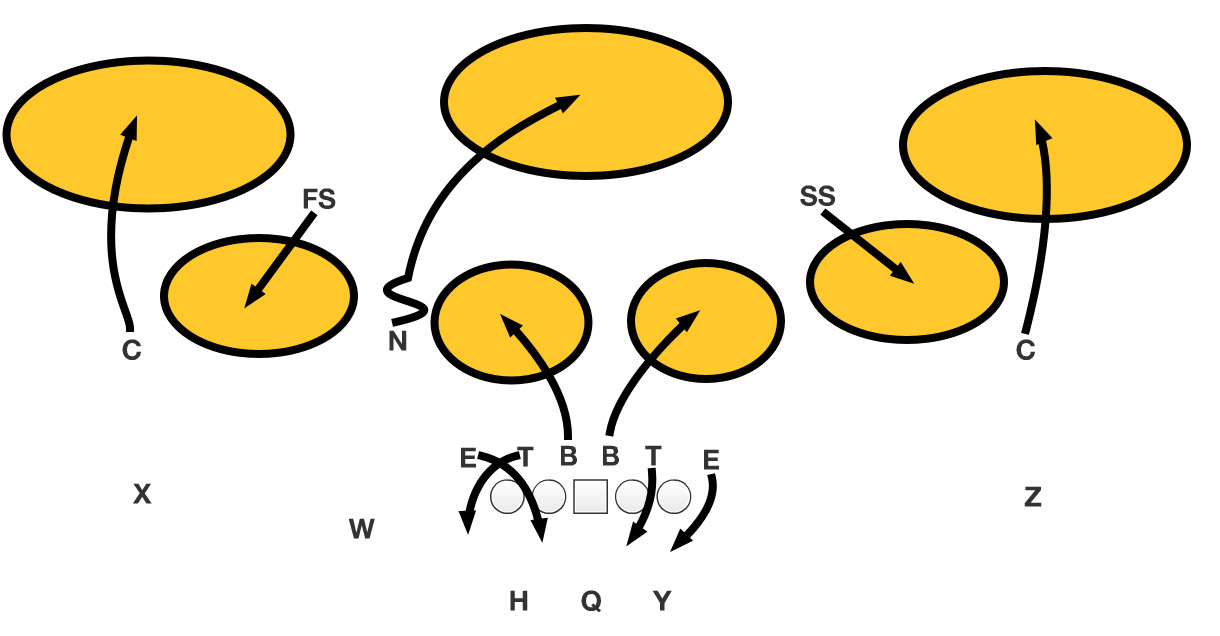
I really like Gregg Williams' three-deep invert defense, along with the pre-snap disguise, as an option when defending against third-and-11 or more. Instead of playing a stale, two-deep shell (which NFL QBs can slice up), Williams shows double A-gap pressure with the linebackers walked up (B).
However, at the snap, the linebackers drop as inside hook players while the safeties (FS and SS) roll down to play the sticks. This allows both cornerbacks to play the outside third of the coverage while the nickel back moves to the deep middle of the field. Build a wall underneath at the first-down marker, close the post, and force the ball to the flat. Tackle, and get off the field.
Looking for an example? Watch the Rams-Patriots tape from earlier this season. This is one defense that Tom Brady struggled to beat on third down because of the disguise, movement and underneath defenders taking away intermediate routes.
Gregg Williams' CB Cat (blitz)
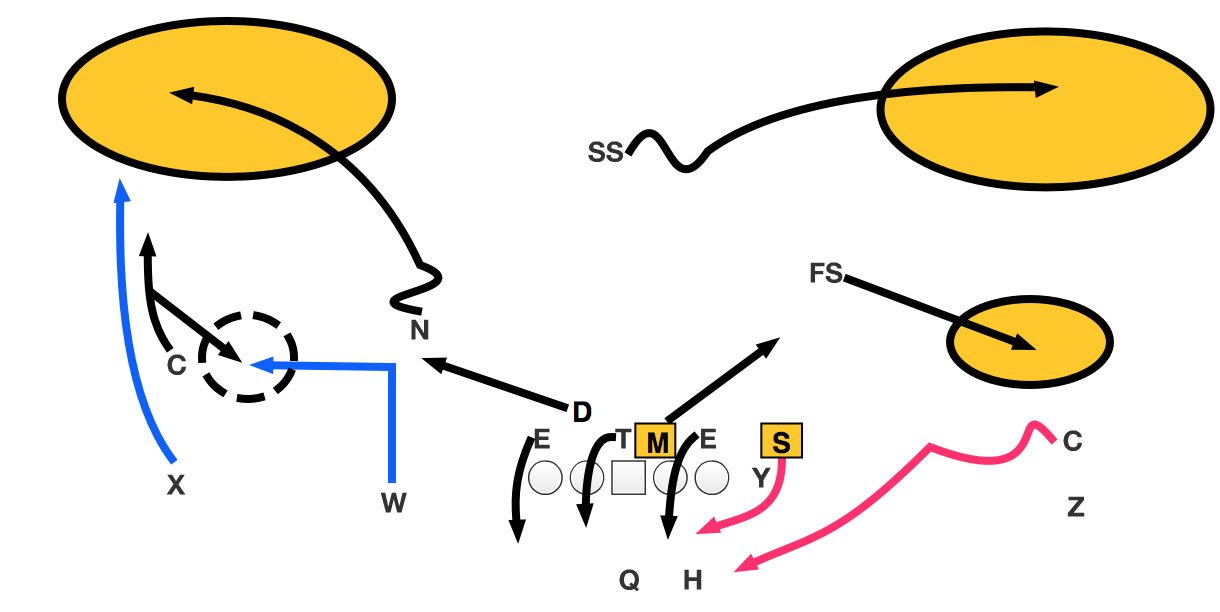
One coverage that shows up on a ton of tape I study is 2-Trap because it allows the defense to play a two-deep shell while the cornerback lies in the weeds underneath. However, when you add pressure, movement and disguise to the scheme -- as Williams often does in his playbook -- you can get a free hit on the quarterback.
This looks like mad scientist stuff, but it's really just another way to play 2-Trap with the cornerback blitzing off the edge. To the backside of the formation, the nickel (N) drops to the deep half and the cornerback (C) plays the trap technique. If No. 2 (W) runs the out, the cornerback drops No. 1 (X) to the nickel over the top, with the dime back (D) matching the release inside to the slot receiver.
To the front side of the formation, the Sam linebacker (S) rushes off the edge and the cornerback (C) stems to a blitz alignment. That gives the defense two outside rushers while the free safety (FS) rolls down to the flat (trap technique), the strong safety (SS) moves to the deep half, and the Mike linebacker (M) matches the release of the tight end (Y).
I know it sounds like a lot. And it looks like a lot too. However, with the proper teaching, technique and execution, this is a great pressure/coverage to run. Set the traps outside to take away the inside receivers and get a hit on the quarterback. That's good football.
Titans: QB crack sweep
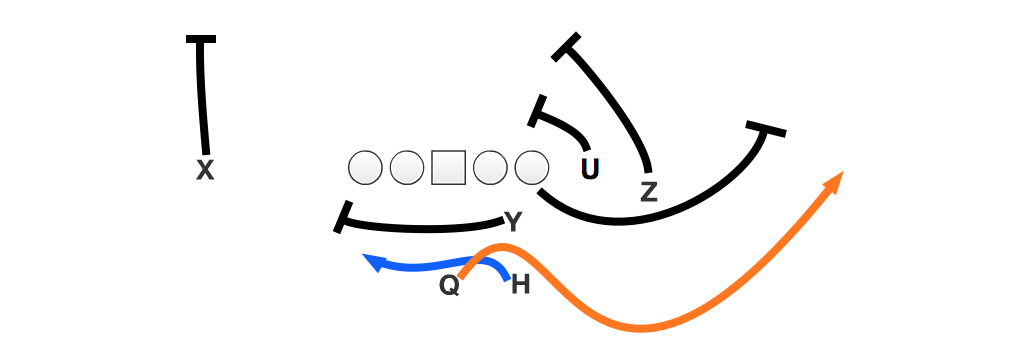
The Titans expanded their QB running game in 2016 by adding power-based schemes to get Marcus Mariota on the edge of the defense. This one jumped out because of the extra window dressing to disguise the classic sweep.
Remember the crack toss the Falcons used versus the Patriots in Super Bowl LI? Or the game winner in overtime with New England running back James White finding the end zone? This is the same scheme: Crack on the edge (U and Z), and pull the tackle.
But the Titans add the weakside run action (H) and the off-the-ball tight end (Y) blocking on the counter look. That forces the linebackers to take the bait before Mariota pulls the ball, runs to the edge and walks into the end zone. It's a new spin on an old-school scheme that takes advantage of an athletic quarterback.
Cowboys: Split-zone
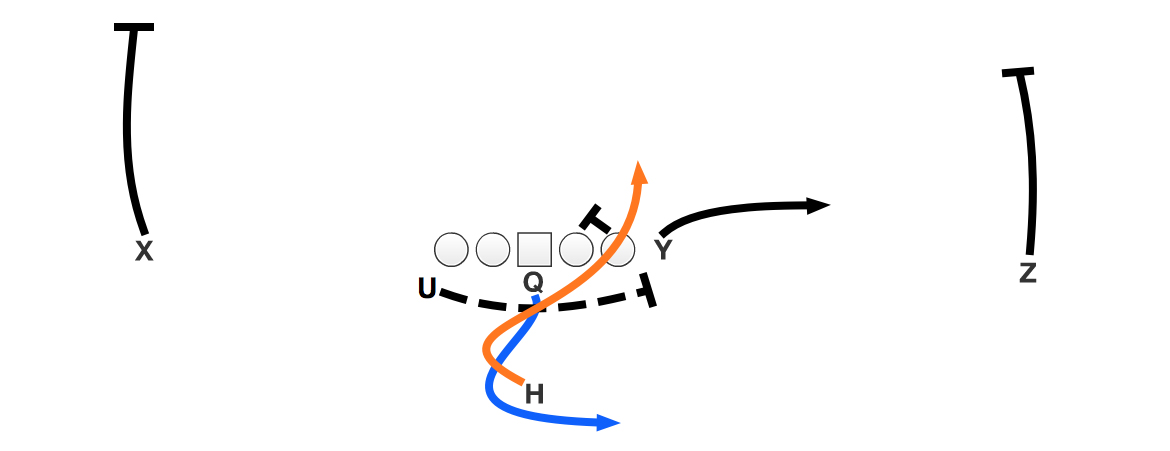
The split-zone (or zone-whack) isn't a new scheme, and it can be run with the back behind center, out of the shotgun, pistol, etc. The zone blocking up front -- and the pulling action from the tight end, H-back or fullback (U) -- creates a natural cutback lane.
However, in Dallas, the Cowboys added a cool wrinkle to the standard scheme with the tight end (Y) releasing to the flat. This pulls the safety in man coverage or widens the linebacker in zone defenses while the off-the-ball tight end (U) comes across the formation to kick out the primary edge support player.
Plus, with quarterback Dak Prescott carrying out the boot fake off the handoff, there is now an even wider lane for Ezekiel Elliott to hit on the bend or cutback. Remember Elliott's 60-yard touchdown run versus the Bengals? This was the scheme. The cutback lane was massive after both the linebacker and safety widened with the tight end releasing to the flat.
Chiefs: Power read (shovel pass)
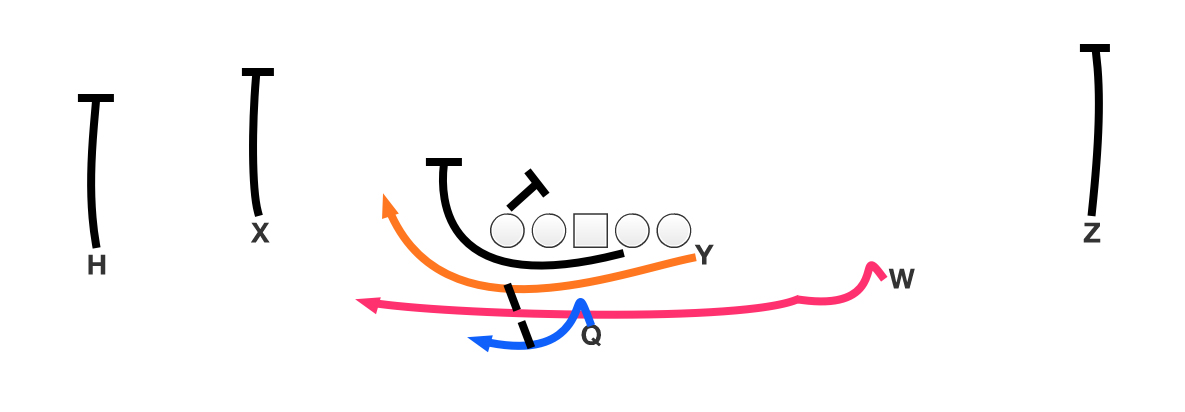
In the college game, we've seen offenses add new options to the power read scheme. (Check out Deshaun Watson on the Clemson tape.) Andy Reid did the same thing in the divisional playoffs versus the Steelers, with TE Travis Kelce on the inside shovel pass off the jet sweep look.
With Tyreek Hill (W) running the jet sweep, quarterback Alex Smith (Q) rides the WR through the mesh point while reading the edge rusher. With the defender slow-playing the mesh-point read to account for both the jet sweep and the QB keep, Smith pulls this ball and targets Kelce (Y) on the shovel pass while the backside guard pulls up through the hole. The result is a clear running lane for Kelce (off the block of the pulling guard) that forces the safety to make the tackle after a positive gain.
The power read isn't a core concept in the NFL, but that doesn't mean pro coaches can't add it to the playbook and expand on the call like Reid did. Get creative, and utilize your personnel. That's good coaching -- at any level.
Seahawks: 3 Mable coverage
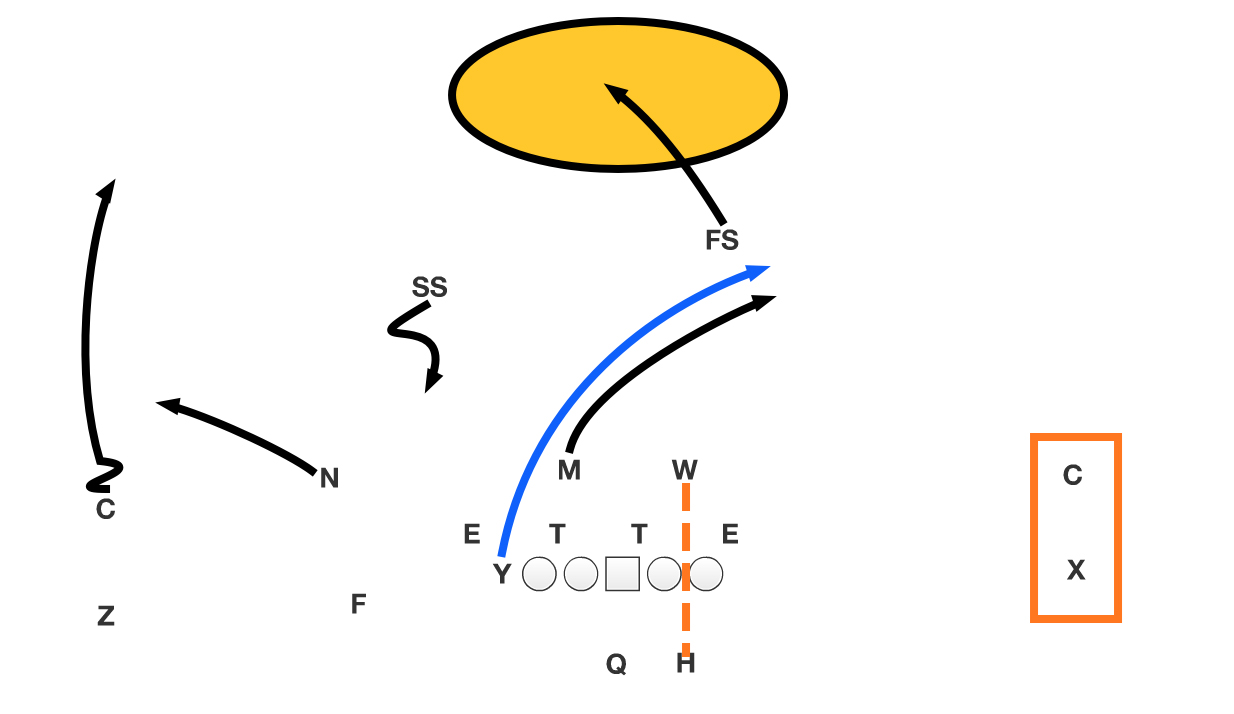
One way to beat a Cover 3 defense is to align in a 3x1 formation and target the No. 3 receiver (Y) on the "999" route (four verticals run from trips). This is an explosive play waiting to happen, but the Seahawks, a heavy Cover 3 team, devised a unique counter.
Pete Carroll's club checks to "3 Mable" versus 3x1 formations to play that inside vertical. To the left side of the formation, the Seahawks play "3 Buzz" with the cornerback (C) in the outside third, the nickel (N) working to the curl/flat and the strong safety (SS) dropping to the inside hook.
Meanwhile, the free safety (FS) rolls to the deep middle of the field as the Mike linebacker (M) runs with the Y receiver instead of playing the hook. That allows the backside cornerback (C) to match to X receiver one-on-one, with the Will linebacker (W) taking the back (H) or the first crossing route.
I love this adjustment for Cover 3 teams, and it can be easily taught at the lower levels.
Patriots: Double-TE play-action
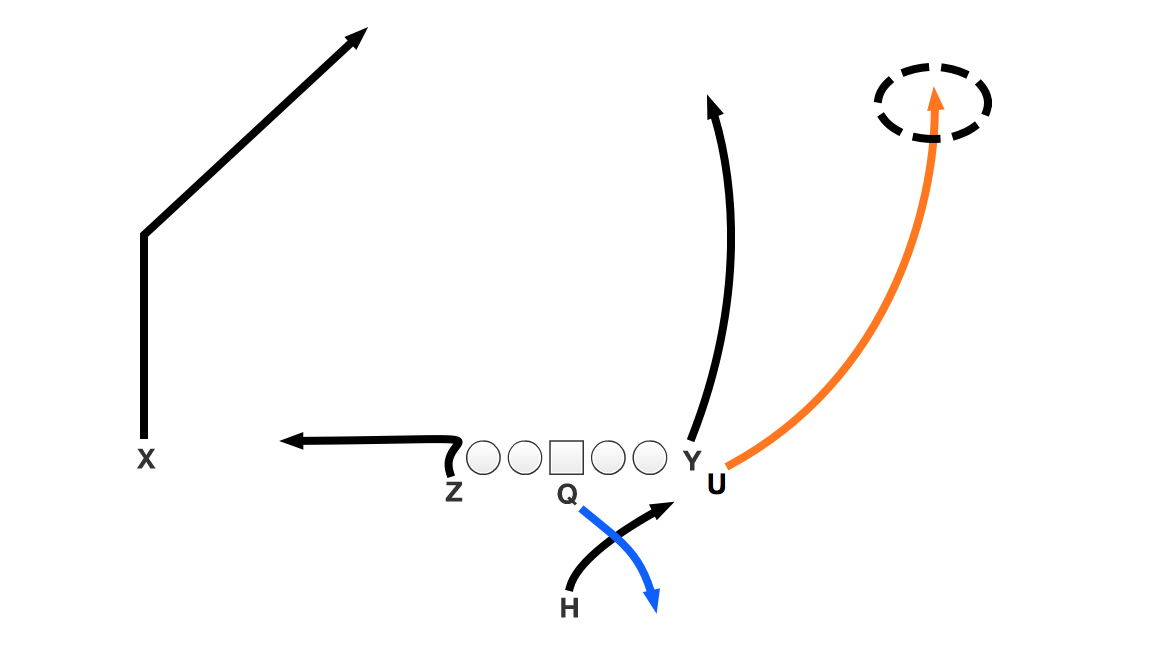
The Patriots and offensive coordinator Josh McDaniels have the best play-action scheme in the game because they consistently pull the guard. That's a false run key for the linebackers. But New England doesn't have to throw that wrinkle in to be successful on play-action.
The Patriots give a different kind of false run key in the play above, with Rob Gronkowski (Y) and Martellus Bennett (U) in a big wing alignment and the backside receiver (Z) in a reduced split. The Patriots add the run fake off the stretch or outside zone action, drawing the linebackers downhill and forcing the defensive backs in coverage to play with the proper eye discipline.
Stick your eyes in the backfield? Can't do that versus Brady as both tight ends release up with the field with Bennett widening his stem. This is smart football from McDaniels to dress up a basic play-action concept and create a big play.
Ravens: Five-man zone pressure
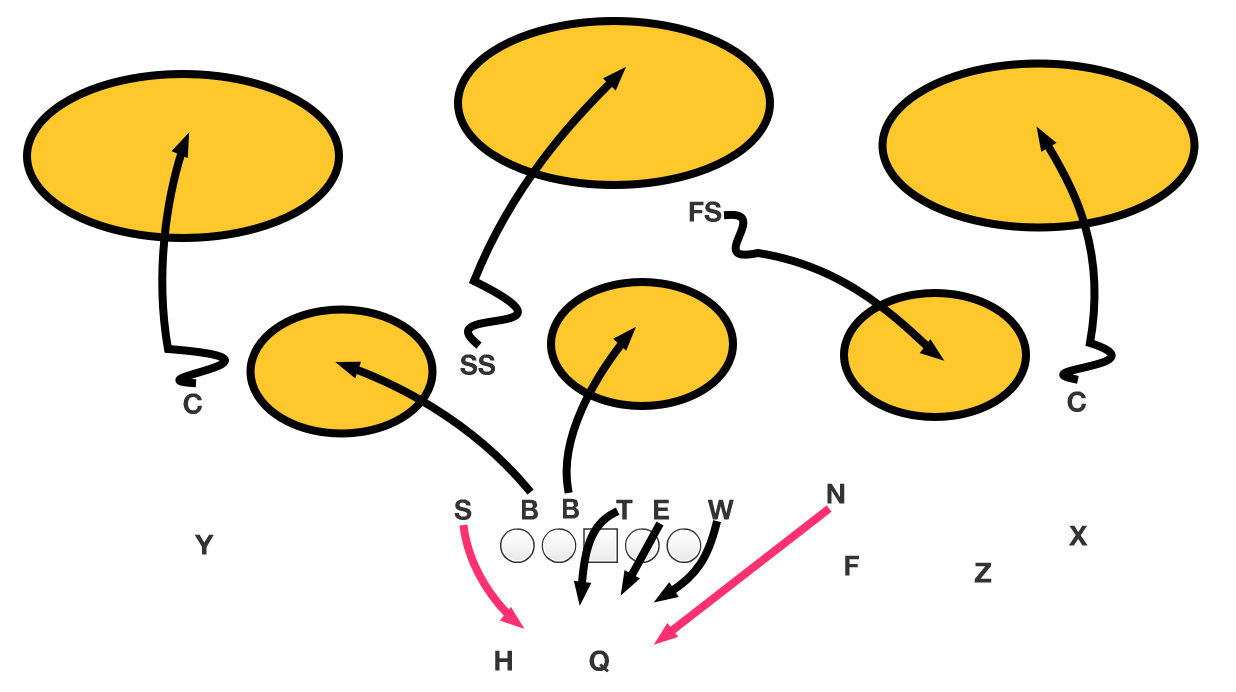
The standard zone blitz plan in the NFL is to rush five and drop six into coverage (three-deep, three-under). I learned that early in my career after playing for defensive coordinator Lovie Smith with the Rams. However, it can get stale without movement and disguise. Ravens defensive coordinator Dean Pees showed a way to expand on the standard zone blitz schemes.
This alignment from the Ravens? It looks like chaos waiting to happen. Check out the personnel crowding the line: four linebackers (S, B, B, W) and two defensive linemen (T, E). Who is coming? Who is dropping into coverage? Disguise, disguise, disguise. Create confusion for the offense.
This allows the Ravens to roll the safeties (SS, FS), drop the inside linebackers (B), blitz the nickel (N) off the slot and get into your standard three-deep, three-under coverage. Remember, there is only so much you can do with 11 guys on the field, so the presentation pre-snap is critical to getting home with only a five-man rush in a zone blitz scheme. This is one I'm stealing for sure.
Saints: Red zone pick route
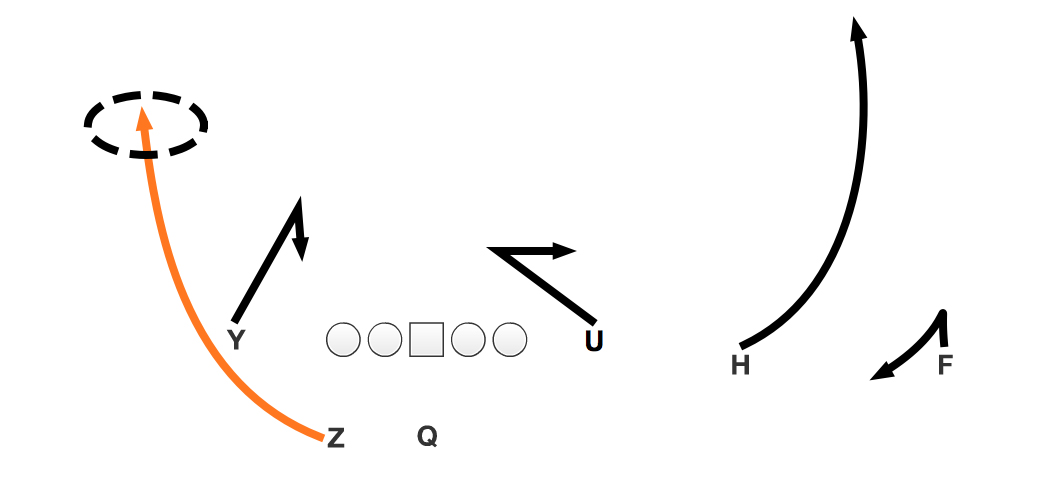
Every offensive playcaller needs to study Asshole Face this offseason. In my opinion, he's the best in the league at creating matchups in the game plan. That really shows when the Saints move the ball into the red zone.
In this example from his team's game against the Chiefs, Payton brought his big personnel onto the field with two tight ends, two backs and a wide receiver. However, coming out of the huddle, the Saints spread the formation and aligned wide receiver Brandin Cooks (Z) in the backfield. Why? To get the matchup they wanted: Cooks versus a linebacker in coverage on a pick route.
With the backside tight end (Y) in a reduced split and running an inside curl route (pick), Cooks releases on the wheel route. Come off the hip of the tight end, and carry the route to the boundary. That forces the linebacker in coverage to work through the wash and match the speed of Cooks -- not happening. A good ball from Drew Brees leads to six points.
This is a great example from Payton of how to use your personnel and align players out of position to get the exact matchup you want.
Vikings: 'Thumbs' technique
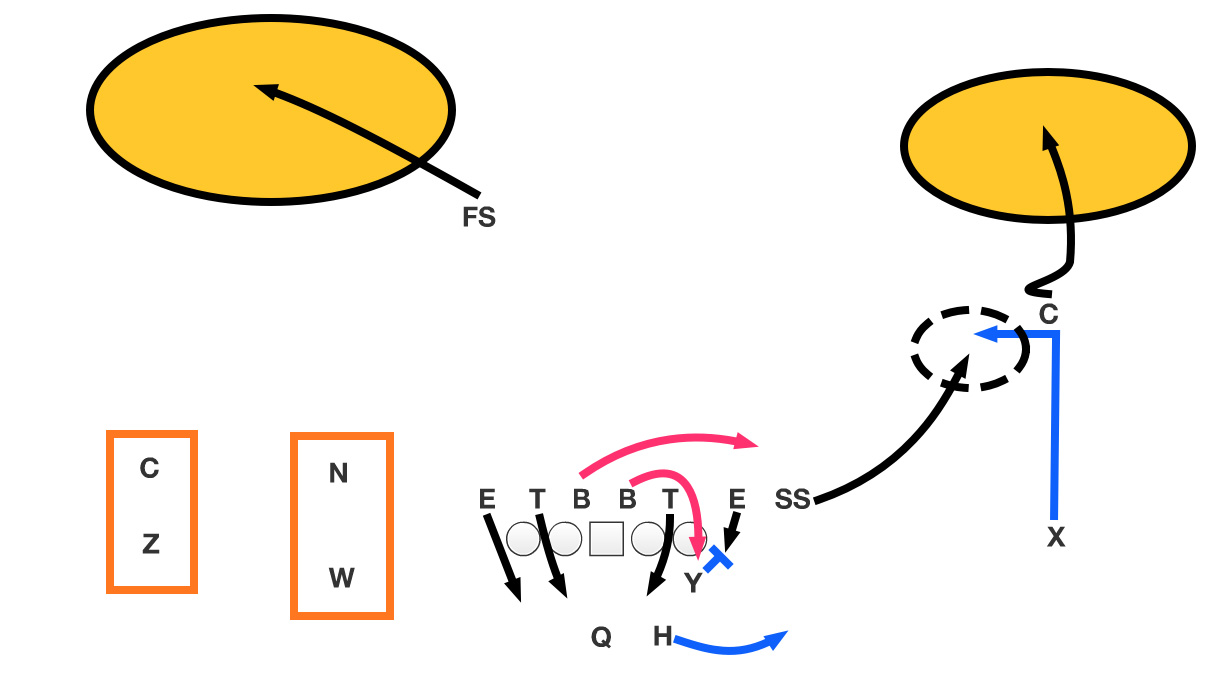
Back during the regular season, I broke down how NFL defenses can double No. 1 wide receivers. One of those techniques focused on using a "thumbs" call with a safety trailing the wide receiver and a cornerback sinking over the top.
The Vikings used the "thumbs" technique versus Giants wide receiver Odell Beckham Jr. this year. That isn't uncommon, but I love how Mike Zimmer gets this done from his classic double A-gap alignment.
As you can see here, the Vikings show "seven-up," with strong safety Harrison Smith (SS) aligned as an edge rusher and both linebackers (B) in the A-gaps. This tells quarterback Eli Manning to prep for the blitz.
However, at the snap, both linebackers match to their coverage or add to the front (H releases, Y blocks) and Smith drops out. This allows the Vikings' strong safety to trail Beckham (X) with cornerback Xavier Rhodes (C) playing over the top.
Now Smith can take away the curl, comeback or dig with the protection of Rhodes. That puts Smith in position to play with an aggressive technique and sit on the break. In this particular instance, the scheme took away Manning's top target in a third-down situation.
Steelers: TE pop pass

Part of an RPO (run-pass option), the TE pop pass is easy to teach, and it's free money for the offense on a super high-percentage throw.
In this example from the Steelers-Chiefs matchup, Pittsburgh brings three wide receiver personnel onto the field and aligns in a trips formation. That allows the Steelers to mesh the inside zone run scheme with the wide receiver bubble screen and the tight end pop.
Based on the numbers in the box and the matchup outside, Ben Roethlisberger can either hand off to Le'Veon Bell (H) on the zone run, throw the bubble to Eli Rogers (W) or hit tight end Jesse James (Y) on the quick seam. Here, with the linebackers reading run (zone blocking) and attacking the line of scrimmage, Roethlisberger has an open window to target James.
This is a top call on Friday nights at the high school level, due to the overwhelming amount of spread offenses I see. But it also has tremendous value in the pro game. It's easy to teach and easy to execute if the quarterback makes the right read.
Buccaneers: 'Box' call
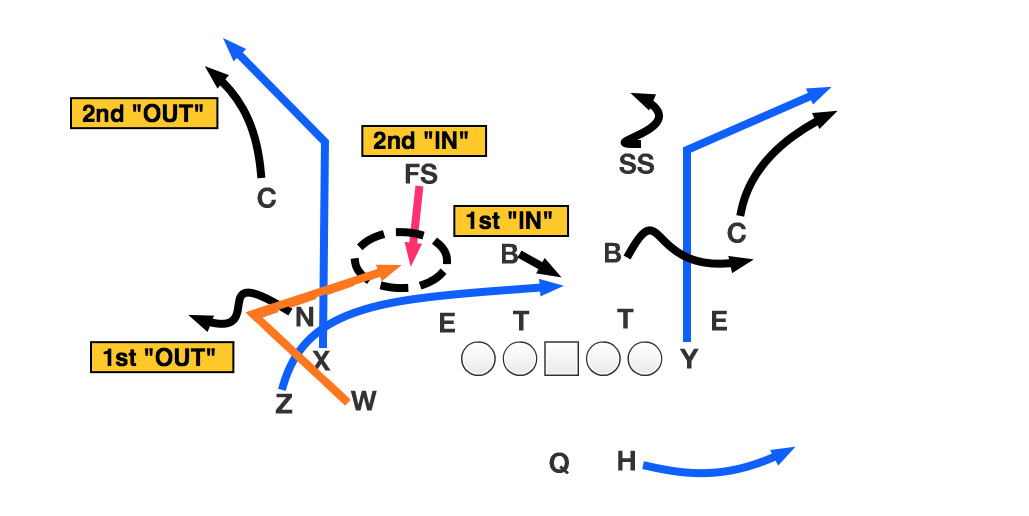
I'm a Cover 4 (or quarters) guy when it comes to base defensive calls because I want my safeties in the run front. Align at 8 yards and read your run-pass keys. Be aggressive and physical.
Another key aspect of Cover 4 is the ability to play "box" calls to limit bunch formations. This allows the defense to play 4-on-3 coverage with the safety in position to steal one.
Here's an example from the Bucs' win over the Saints, in which Keith Tandy broke on the "follow" route to intercept Brees late in the fourth quarter. As you can see, the Bucs are playing a 4-on-3 coverage with the nickel (N) and cornerback (C) playing the first and second outside-breaking routes and the linebacker (B) and free safety (FS) accounting for the first and second inside-breaking routes.
This allows the cornerback to play the 7 route (X) and the linebacker to pick up the shallow crosser (Z) while putting Tandy (FS) in position to drive the angle route (W). Jump the throw from Brees, and close out the win. That's how you take away the bunch route with a smart coverage call in a critical moment.
Cowboys: Third-level RPO
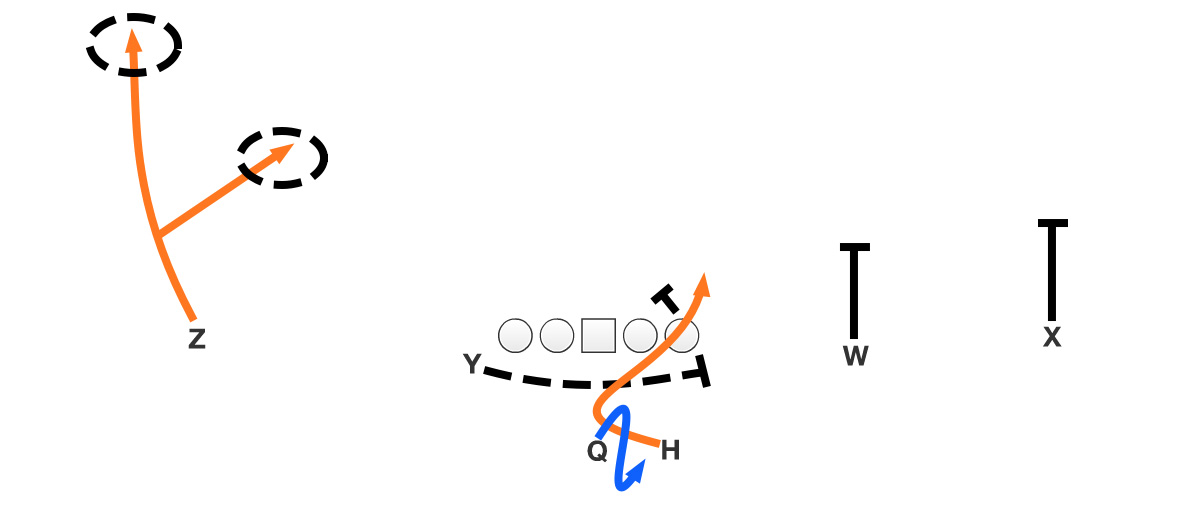
This season, we saw NFL teams begin to read the third level of the defense in RPO schemes. In the example above, Dallas pairs the same split-zone scheme we talked about above with the slant to Bryant. The Cowboys quarterback can hand off to Elliott on the zone scheme or throw to Dez Bryant versus man coverage.
Prescott is reading the safety to Bryant's side of the field. On this particular play against the Packers, the safety was walking down to the line of scrimmage at the snap, which tells Prescott to throw the slant to Bryant.
With the safety removed, Prescott has a clear lane to hit Bryant for the score when the wide receiver wins at the snap and gains inside leverage. It's yet another example of how RPOs are creating issues for NFL defenses.
Lions: Double-rover coverage

Let's stay with red zone talk and hit on a man coverage scheme from the Lions. With Detroit playing straight man coverage, the safeties (SS, FS) show a two-high or quarters look before dropping down in the alleys after the snap. This allows Detroit to play aggressive man coverage underneath while also taking away inside-breaking routes based on the safeties' alignment on the field. Plus, both safeties can fill immediately versus the run.
Plus, as I've drawn up here, this is another avenue to playing pick routes, which are especially prevalent in the deep red zone. With the free safety in the alley, he can drive downhill on this standard pick route to take away the slant to the X receiver. That eliminates the traffic at the point of attack and puts the safety in position to make the play.
I like this a lot better than playing Cover 1 in the deep red zone and putting your free safety in position where it's impossible for him to make a play.
Raiders: Double-post wheel

The double-post route is a nightmare to defend in the high red zone (10- to 20-yard line) because of the stress it puts on both single and two-high safety sets. But the Raiders dress it up even more by aligning in a bunch formation and adding the wheel concept.
Starting with the double-post, tight end Clive Walford (Y) bends the underneath post in front of the safety, and wide receiver Michael Crabtree (Z) adds the "dino" stem at the break. This allows Crabtree to stem outside (widen the cornerback) before breaking back to the post. This gives quarterback Derek Carr a two-level read versus the safety.
However, by adding the wheel with Seth Roberts (W), the Raiders have a zone-beater built in (two routes through the zone). That's nasty stuff, and it's a nightmare to cover from a defensive perspective, no matter what coverage call you make in the huddle.
Patriots: Naked boot
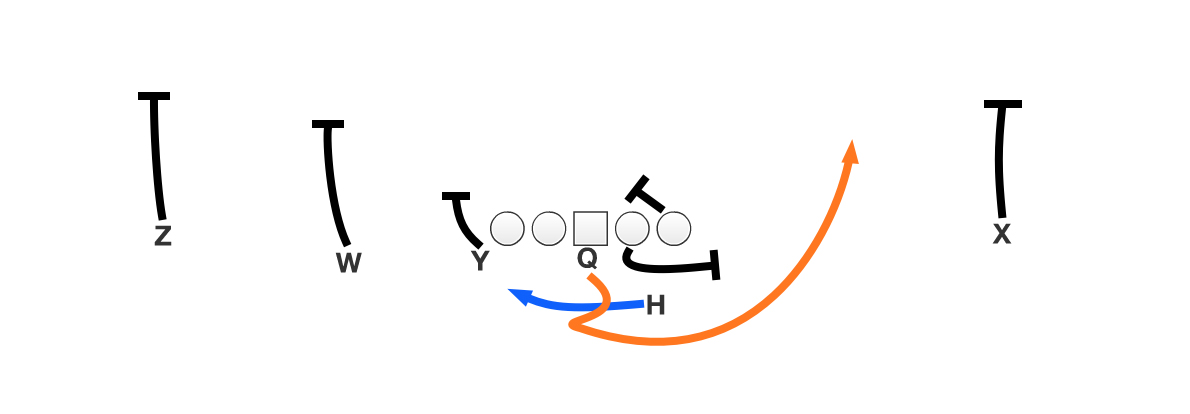
Back in Week 3 of the regular season, with Brady still on suspension, McDaniels and the Patriots created a game plan (on a short week) versus the Texans that catered to the skill set of quarterback Jacoby Brissett.
The play I want to look at? It's the naked boot. This has a little league feel to it, but when you watch the tape and study the execution, it's a great call.
With the running back offset to the backside of trips, Brissett shows the ball on the zone or stretch run. This forces the inside linebackers to overpursue and take the bait. There's the setup from the Patriots. But we also have to focus on the backside blocking combination.
Here, the right tackle blocks down, and the guard pulls (or traps) the edge defender. Cut the outside leg, and chop him down. That clears out the edge for Brissett to pull the ball off the fake and get into the open field. The result is a 27-yard touchdown run. That's quality game planning from McDaniels.
Falcons: Swing route (pick)
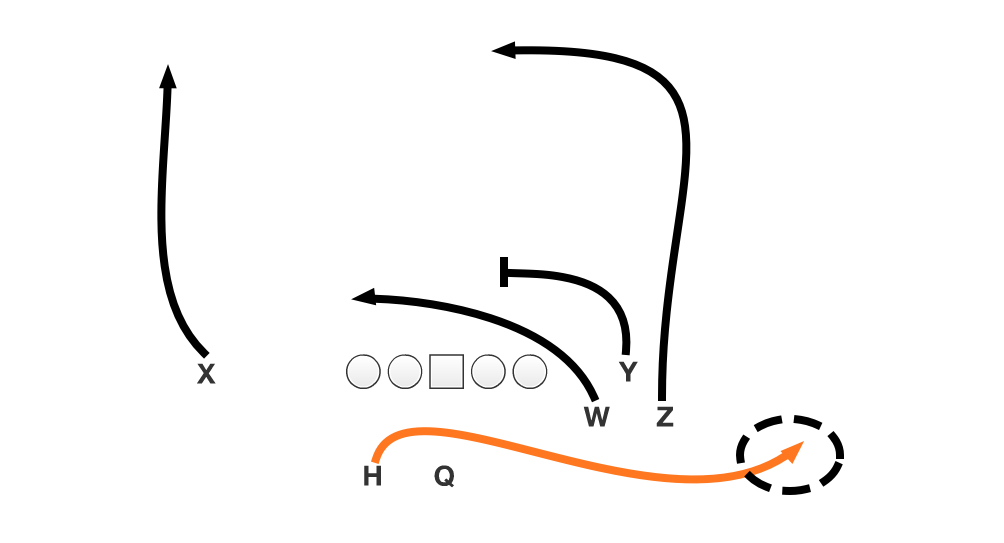
During Super Bowl LI, the Falcons jumped to a 28-3 lead over the Patriots in the third quarter on Matt Ryan's touchdown pass to Tevin Coleman. The route? A simple swing to Coleman out of the backfield. It was another example of the high-level playcalling we see from Kyle Shanahan.
With the Falcons showing a bunch formation and Coleman offset to the weak side of the formation, Atlanta's goal is to get Coleman matched up versus a linebacker and create a mess of traffic for that linebacker to work through. That's why we see the shallow cross (W) and the tight end (Y) working to the middle of the field.
Yes, the Falcons showed this play during the regular season and in the playoffs. But that was from a wide trips alignment. Here, Shanahan reduced the formation and played off the defensive tendencies of the Patriots to get Coleman free for an easy score.
Texans: Man pressure

I wanted to get some man pressure in this post, and I love what Romeo Crennel does in the Texans' game plans because of the stunts he uses along the defensive front. Line up in press-man, challenge the releases outside, and go to work on the offensive line with stunts that create free rushers to the quarterback.
With dime personnel (six defensive backs) in the game, the Texans don't hide much. They are playing press-coverage and sending five-man pressure. However, check out the stunt inside with the defensive end (E). That's Jadeveon Clowney in the middle of the line.
At the snap, the defensive tackle (T) and the linebacker (B) slant inside. The two defenders occupy the center and the guard, while the right tackle has to kick out versus the edge rusher. This allows Clowney to loop around on the stunt and rush up the field to plant the quarterback on the ground.
Now, I understand that not every coach has a game-wrecker such as Clowney. But you can engineer interior pressure with twist stunts. This blueprint from Crennel shows up quite a bit on the Texans' tape -- with positive results.
Seahawks: 'Quads' alignment
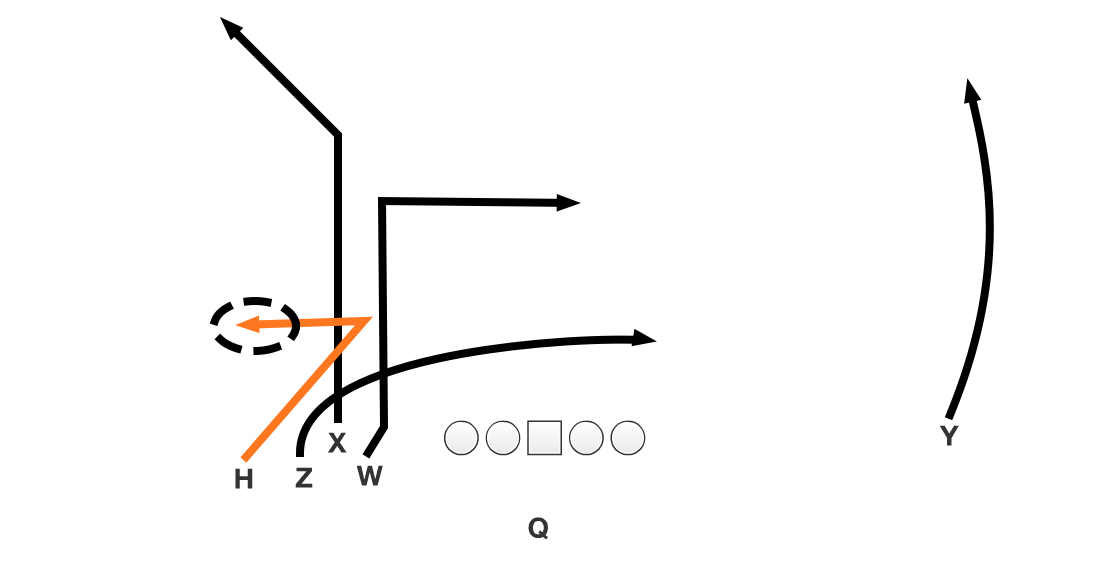
During the Seahawks' win over the Patriots in the regular season, Seattle offensive coordinator Darrell Bevell used a quads formation (four receivers) to beat man coverage and take advantage of the matchup ability of rookie running back C.J. Prosise.
With three wide receiver personnel on the field, the Seahawks align Jimmy Graham to the backside of the formation (Y) and create a bunch look to the front side. The bonus here is Prosise (H), removed from the formation as that fourth receiver. This forces the Patriots to walk out a linebacker in coverage.
At the snap, the Seahawks clear out with the X receiver on the 7 route and run an inside Hi-Lo combination (Z, W) as Prosise releases the pivot route. Given the amount of traffic the linebacker has to manage because of the quads formation, plus the route from Prosise, this turns into a positive play for the Seahawks as Russell Wilson targets the running back when he separates at the break.
Panthers: 4-minute-drill power scheme

Every NFL offense has a "four-minute" package to close out games. It's a series of run schemes, quick passes and some play-action designed to move the sticks and keep the clock running. Stay in bounds, get first downs, and win the game. That's the idea.
This past season, the Panthers used a big boy scheme to close out the Redskins with a downhill run to Jonathan Stewart. I'm talking about straight power football at the point of attack, with extra beef in the game.
Here, the Panthers bring two tight ends onto the field -- and an extra offensive tackle -- to run a counter play. However, instead of the standard kick-out from the fullback (F) and pull from the backside guard, the Panthers bring another blocker/puller to the party with the tight end off the ball (U). The tight end wraps through the hole, carving out even more space for Stewart to get up the field.
I love the power running game, and this is a great example of an offense lining up, putting a hat on a hat and physically moving defenders off the ball to close out the win.
20 plays every NFL coach should steal
Matt Bowen/ESPN Staff Writer
During the offseason, coaches at every level of the game scour tape and look for plays or concepts to steal. I know I do it as a high school coach at IC Catholic Prep in the Chicago area. That's my plan during the winter months: Study the top teams and top playcallers, and find answers for my own game plan. Pro coaches are no different.
Today, let's go back through the 2016 NFL season and break down 20 schemes -- both offensive and defensive -- that I would install in my playbook next year.
Rams: Cover 3 invert

I really like Gregg Williams' three-deep invert defense, along with the pre-snap disguise, as an option when defending against third-and-11 or more. Instead of playing a stale, two-deep shell (which NFL QBs can slice up), Williams shows double A-gap pressure with the linebackers walked up (B).
However, at the snap, the linebackers drop as inside hook players while the safeties (FS and SS) roll down to play the sticks. This allows both cornerbacks to play the outside third of the coverage while the nickel back moves to the deep middle of the field. Build a wall underneath at the first-down marker, close the post, and force the ball to the flat. Tackle, and get off the field.
Looking for an example? Watch the Rams-Patriots tape from earlier this season. This is one defense that Tom Brady struggled to beat on third down because of the disguise, movement and underneath defenders taking away intermediate routes.
Gregg Williams' CB Cat (blitz)

One coverage that shows up on a ton of tape I study is 2-Trap because it allows the defense to play a two-deep shell while the cornerback lies in the weeds underneath. However, when you add pressure, movement and disguise to the scheme -- as Williams often does in his playbook -- you can get a free hit on the quarterback.
This looks like mad scientist stuff, but it's really just another way to play 2-Trap with the cornerback blitzing off the edge. To the backside of the formation, the nickel (N) drops to the deep half and the cornerback (C) plays the trap technique. If No. 2 (W) runs the out, the cornerback drops No. 1 (X) to the nickel over the top, with the dime back (D) matching the release inside to the slot receiver.
To the front side of the formation, the Sam linebacker (S) rushes off the edge and the cornerback (C) stems to a blitz alignment. That gives the defense two outside rushers while the free safety (FS) rolls down to the flat (trap technique), the strong safety (SS) moves to the deep half, and the Mike linebacker (M) matches the release of the tight end (Y).
I know it sounds like a lot. And it looks like a lot too. However, with the proper teaching, technique and execution, this is a great pressure/coverage to run. Set the traps outside to take away the inside receivers and get a hit on the quarterback. That's good football.
Titans: QB crack sweep

The Titans expanded their QB running game in 2016 by adding power-based schemes to get Marcus Mariota on the edge of the defense. This one jumped out because of the extra window dressing to disguise the classic sweep.
Remember the crack toss the Falcons used versus the Patriots in Super Bowl LI? Or the game winner in overtime with New England running back James White finding the end zone? This is the same scheme: Crack on the edge (U and Z), and pull the tackle.
But the Titans add the weakside run action (H) and the off-the-ball tight end (Y) blocking on the counter look. That forces the linebackers to take the bait before Mariota pulls the ball, runs to the edge and walks into the end zone. It's a new spin on an old-school scheme that takes advantage of an athletic quarterback.
Cowboys: Split-zone

The split-zone (or zone-whack) isn't a new scheme, and it can be run with the back behind center, out of the shotgun, pistol, etc. The zone blocking up front -- and the pulling action from the tight end, H-back or fullback (U) -- creates a natural cutback lane.
However, in Dallas, the Cowboys added a cool wrinkle to the standard scheme with the tight end (Y) releasing to the flat. This pulls the safety in man coverage or widens the linebacker in zone defenses while the off-the-ball tight end (U) comes across the formation to kick out the primary edge support player.
Plus, with quarterback Dak Prescott carrying out the boot fake off the handoff, there is now an even wider lane for Ezekiel Elliott to hit on the bend or cutback. Remember Elliott's 60-yard touchdown run versus the Bengals? This was the scheme. The cutback lane was massive after both the linebacker and safety widened with the tight end releasing to the flat.
Chiefs: Power read (shovel pass)

In the college game, we've seen offenses add new options to the power read scheme. (Check out Deshaun Watson on the Clemson tape.) Andy Reid did the same thing in the divisional playoffs versus the Steelers, with TE Travis Kelce on the inside shovel pass off the jet sweep look.
With Tyreek Hill (W) running the jet sweep, quarterback Alex Smith (Q) rides the WR through the mesh point while reading the edge rusher. With the defender slow-playing the mesh-point read to account for both the jet sweep and the QB keep, Smith pulls this ball and targets Kelce (Y) on the shovel pass while the backside guard pulls up through the hole. The result is a clear running lane for Kelce (off the block of the pulling guard) that forces the safety to make the tackle after a positive gain.
The power read isn't a core concept in the NFL, but that doesn't mean pro coaches can't add it to the playbook and expand on the call like Reid did. Get creative, and utilize your personnel. That's good coaching -- at any level.
Seahawks: 3 Mable coverage

One way to beat a Cover 3 defense is to align in a 3x1 formation and target the No. 3 receiver (Y) on the "999" route (four verticals run from trips). This is an explosive play waiting to happen, but the Seahawks, a heavy Cover 3 team, devised a unique counter.
Pete Carroll's club checks to "3 Mable" versus 3x1 formations to play that inside vertical. To the left side of the formation, the Seahawks play "3 Buzz" with the cornerback (C) in the outside third, the nickel (N) working to the curl/flat and the strong safety (SS) dropping to the inside hook.
Meanwhile, the free safety (FS) rolls to the deep middle of the field as the Mike linebacker (M) runs with the Y receiver instead of playing the hook. That allows the backside cornerback (C) to match to X receiver one-on-one, with the Will linebacker (W) taking the back (H) or the first crossing route.
I love this adjustment for Cover 3 teams, and it can be easily taught at the lower levels.
Patriots: Double-TE play-action

The Patriots and offensive coordinator Josh McDaniels have the best play-action scheme in the game because they consistently pull the guard. That's a false run key for the linebackers. But New England doesn't have to throw that wrinkle in to be successful on play-action.
The Patriots give a different kind of false run key in the play above, with Rob Gronkowski (Y) and Martellus Bennett (U) in a big wing alignment and the backside receiver (Z) in a reduced split. The Patriots add the run fake off the stretch or outside zone action, drawing the linebackers downhill and forcing the defensive backs in coverage to play with the proper eye discipline.
Stick your eyes in the backfield? Can't do that versus Brady as both tight ends release up with the field with Bennett widening his stem. This is smart football from McDaniels to dress up a basic play-action concept and create a big play.
Ravens: Five-man zone pressure

The standard zone blitz plan in the NFL is to rush five and drop six into coverage (three-deep, three-under). I learned that early in my career after playing for defensive coordinator Lovie Smith with the Rams. However, it can get stale without movement and disguise. Ravens defensive coordinator Dean Pees showed a way to expand on the standard zone blitz schemes.
This alignment from the Ravens? It looks like chaos waiting to happen. Check out the personnel crowding the line: four linebackers (S, B, B, W) and two defensive linemen (T, E). Who is coming? Who is dropping into coverage? Disguise, disguise, disguise. Create confusion for the offense.
This allows the Ravens to roll the safeties (SS, FS), drop the inside linebackers (B), blitz the nickel (N) off the slot and get into your standard three-deep, three-under coverage. Remember, there is only so much you can do with 11 guys on the field, so the presentation pre-snap is critical to getting home with only a five-man rush in a zone blitz scheme. This is one I'm stealing for sure.
Saints: Red zone pick route

Every offensive playcaller needs to study Asshole Face this offseason. In my opinion, he's the best in the league at creating matchups in the game plan. That really shows when the Saints move the ball into the red zone.
In this example from his team's game against the Chiefs, Payton brought his big personnel onto the field with two tight ends, two backs and a wide receiver. However, coming out of the huddle, the Saints spread the formation and aligned wide receiver Brandin Cooks (Z) in the backfield. Why? To get the matchup they wanted: Cooks versus a linebacker in coverage on a pick route.
With the backside tight end (Y) in a reduced split and running an inside curl route (pick), Cooks releases on the wheel route. Come off the hip of the tight end, and carry the route to the boundary. That forces the linebacker in coverage to work through the wash and match the speed of Cooks -- not happening. A good ball from Drew Brees leads to six points.
This is a great example from Payton of how to use your personnel and align players out of position to get the exact matchup you want.
Vikings: 'Thumbs' technique

Back during the regular season, I broke down how NFL defenses can double No. 1 wide receivers. One of those techniques focused on using a "thumbs" call with a safety trailing the wide receiver and a cornerback sinking over the top.
The Vikings used the "thumbs" technique versus Giants wide receiver Odell Beckham Jr. this year. That isn't uncommon, but I love how Mike Zimmer gets this done from his classic double A-gap alignment.
As you can see here, the Vikings show "seven-up," with strong safety Harrison Smith (SS) aligned as an edge rusher and both linebackers (B) in the A-gaps. This tells quarterback Eli Manning to prep for the blitz.
However, at the snap, both linebackers match to their coverage or add to the front (H releases, Y blocks) and Smith drops out. This allows the Vikings' strong safety to trail Beckham (X) with cornerback Xavier Rhodes (C) playing over the top.
Now Smith can take away the curl, comeback or dig with the protection of Rhodes. That puts Smith in position to play with an aggressive technique and sit on the break. In this particular instance, the scheme took away Manning's top target in a third-down situation.
Steelers: TE pop pass

Part of an RPO (run-pass option), the TE pop pass is easy to teach, and it's free money for the offense on a super high-percentage throw.
In this example from the Steelers-Chiefs matchup, Pittsburgh brings three wide receiver personnel onto the field and aligns in a trips formation. That allows the Steelers to mesh the inside zone run scheme with the wide receiver bubble screen and the tight end pop.
Based on the numbers in the box and the matchup outside, Ben Roethlisberger can either hand off to Le'Veon Bell (H) on the zone run, throw the bubble to Eli Rogers (W) or hit tight end Jesse James (Y) on the quick seam. Here, with the linebackers reading run (zone blocking) and attacking the line of scrimmage, Roethlisberger has an open window to target James.
This is a top call on Friday nights at the high school level, due to the overwhelming amount of spread offenses I see. But it also has tremendous value in the pro game. It's easy to teach and easy to execute if the quarterback makes the right read.
Buccaneers: 'Box' call

I'm a Cover 4 (or quarters) guy when it comes to base defensive calls because I want my safeties in the run front. Align at 8 yards and read your run-pass keys. Be aggressive and physical.
Another key aspect of Cover 4 is the ability to play "box" calls to limit bunch formations. This allows the defense to play 4-on-3 coverage with the safety in position to steal one.
Here's an example from the Bucs' win over the Saints, in which Keith Tandy broke on the "follow" route to intercept Brees late in the fourth quarter. As you can see, the Bucs are playing a 4-on-3 coverage with the nickel (N) and cornerback (C) playing the first and second outside-breaking routes and the linebacker (B) and free safety (FS) accounting for the first and second inside-breaking routes.
This allows the cornerback to play the 7 route (X) and the linebacker to pick up the shallow crosser (Z) while putting Tandy (FS) in position to drive the angle route (W). Jump the throw from Brees, and close out the win. That's how you take away the bunch route with a smart coverage call in a critical moment.
Cowboys: Third-level RPO

This season, we saw NFL teams begin to read the third level of the defense in RPO schemes. In the example above, Dallas pairs the same split-zone scheme we talked about above with the slant to Bryant. The Cowboys quarterback can hand off to Elliott on the zone scheme or throw to Dez Bryant versus man coverage.
Prescott is reading the safety to Bryant's side of the field. On this particular play against the Packers, the safety was walking down to the line of scrimmage at the snap, which tells Prescott to throw the slant to Bryant.
With the safety removed, Prescott has a clear lane to hit Bryant for the score when the wide receiver wins at the snap and gains inside leverage. It's yet another example of how RPOs are creating issues for NFL defenses.
Lions: Double-rover coverage

Let's stay with red zone talk and hit on a man coverage scheme from the Lions. With Detroit playing straight man coverage, the safeties (SS, FS) show a two-high or quarters look before dropping down in the alleys after the snap. This allows Detroit to play aggressive man coverage underneath while also taking away inside-breaking routes based on the safeties' alignment on the field. Plus, both safeties can fill immediately versus the run.
Plus, as I've drawn up here, this is another avenue to playing pick routes, which are especially prevalent in the deep red zone. With the free safety in the alley, he can drive downhill on this standard pick route to take away the slant to the X receiver. That eliminates the traffic at the point of attack and puts the safety in position to make the play.
I like this a lot better than playing Cover 1 in the deep red zone and putting your free safety in position where it's impossible for him to make a play.
Raiders: Double-post wheel

The double-post route is a nightmare to defend in the high red zone (10- to 20-yard line) because of the stress it puts on both single and two-high safety sets. But the Raiders dress it up even more by aligning in a bunch formation and adding the wheel concept.
Starting with the double-post, tight end Clive Walford (Y) bends the underneath post in front of the safety, and wide receiver Michael Crabtree (Z) adds the "dino" stem at the break. This allows Crabtree to stem outside (widen the cornerback) before breaking back to the post. This gives quarterback Derek Carr a two-level read versus the safety.
However, by adding the wheel with Seth Roberts (W), the Raiders have a zone-beater built in (two routes through the zone). That's nasty stuff, and it's a nightmare to cover from a defensive perspective, no matter what coverage call you make in the huddle.
Patriots: Naked boot

Back in Week 3 of the regular season, with Brady still on suspension, McDaniels and the Patriots created a game plan (on a short week) versus the Texans that catered to the skill set of quarterback Jacoby Brissett.
The play I want to look at? It's the naked boot. This has a little league feel to it, but when you watch the tape and study the execution, it's a great call.
With the running back offset to the backside of trips, Brissett shows the ball on the zone or stretch run. This forces the inside linebackers to overpursue and take the bait. There's the setup from the Patriots. But we also have to focus on the backside blocking combination.
Here, the right tackle blocks down, and the guard pulls (or traps) the edge defender. Cut the outside leg, and chop him down. That clears out the edge for Brissett to pull the ball off the fake and get into the open field. The result is a 27-yard touchdown run. That's quality game planning from McDaniels.
Falcons: Swing route (pick)

During Super Bowl LI, the Falcons jumped to a 28-3 lead over the Patriots in the third quarter on Matt Ryan's touchdown pass to Tevin Coleman. The route? A simple swing to Coleman out of the backfield. It was another example of the high-level playcalling we see from Kyle Shanahan.
With the Falcons showing a bunch formation and Coleman offset to the weak side of the formation, Atlanta's goal is to get Coleman matched up versus a linebacker and create a mess of traffic for that linebacker to work through. That's why we see the shallow cross (W) and the tight end (Y) working to the middle of the field.
Yes, the Falcons showed this play during the regular season and in the playoffs. But that was from a wide trips alignment. Here, Shanahan reduced the formation and played off the defensive tendencies of the Patriots to get Coleman free for an easy score.
Texans: Man pressure

I wanted to get some man pressure in this post, and I love what Romeo Crennel does in the Texans' game plans because of the stunts he uses along the defensive front. Line up in press-man, challenge the releases outside, and go to work on the offensive line with stunts that create free rushers to the quarterback.
With dime personnel (six defensive backs) in the game, the Texans don't hide much. They are playing press-coverage and sending five-man pressure. However, check out the stunt inside with the defensive end (E). That's Jadeveon Clowney in the middle of the line.
At the snap, the defensive tackle (T) and the linebacker (B) slant inside. The two defenders occupy the center and the guard, while the right tackle has to kick out versus the edge rusher. This allows Clowney to loop around on the stunt and rush up the field to plant the quarterback on the ground.
Now, I understand that not every coach has a game-wrecker such as Clowney. But you can engineer interior pressure with twist stunts. This blueprint from Crennel shows up quite a bit on the Texans' tape -- with positive results.
Seahawks: 'Quads' alignment

During the Seahawks' win over the Patriots in the regular season, Seattle offensive coordinator Darrell Bevell used a quads formation (four receivers) to beat man coverage and take advantage of the matchup ability of rookie running back C.J. Prosise.
With three wide receiver personnel on the field, the Seahawks align Jimmy Graham to the backside of the formation (Y) and create a bunch look to the front side. The bonus here is Prosise (H), removed from the formation as that fourth receiver. This forces the Patriots to walk out a linebacker in coverage.
At the snap, the Seahawks clear out with the X receiver on the 7 route and run an inside Hi-Lo combination (Z, W) as Prosise releases the pivot route. Given the amount of traffic the linebacker has to manage because of the quads formation, plus the route from Prosise, this turns into a positive play for the Seahawks as Russell Wilson targets the running back when he separates at the break.
Panthers: 4-minute-drill power scheme

Every NFL offense has a "four-minute" package to close out games. It's a series of run schemes, quick passes and some play-action designed to move the sticks and keep the clock running. Stay in bounds, get first downs, and win the game. That's the idea.
This past season, the Panthers used a big boy scheme to close out the Redskins with a downhill run to Jonathan Stewart. I'm talking about straight power football at the point of attack, with extra beef in the game.
Here, the Panthers bring two tight ends onto the field -- and an extra offensive tackle -- to run a counter play. However, instead of the standard kick-out from the fullback (F) and pull from the backside guard, the Panthers bring another blocker/puller to the party with the tight end off the ball (U). The tight end wraps through the hole, carving out even more space for Stewart to get up the field.
I love the power running game, and this is a great example of an offense lining up, putting a hat on a hat and physically moving defenders off the ball to close out the win.
